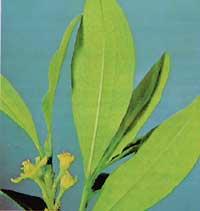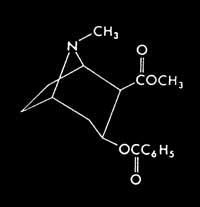Coca and cocaine

Cocaine is an alkaloid extracted from coca leaves. It is used as a local anesthetic and produces drug addiction and serious toxic effects. The term alkaloid means “as alkalis or bases” and is applied to more than one plant tissue of natural nitrogenous compounds. Popular medicine has used most of them throughout the centuries. Guindilla (paprika), nicotine (tobacco), quinine (quinine), morphine (opium) or mescaline (mescaline) are known alkaloids. Due to its complexity and structural diversity, the names of the plants found have been designated by adding the -ina suffix. They are usually present in the skin, leaves, seeds or roots, and sometimes in the same plant some alkaloids with similar structure can be found.
From a chemical point of view, cocaine is a benzilmethyl ecgonine (C17 H21NO4) and structurally related to atropine. Gaedake isolated with diluted acid from the coca leaves dissolved in calcium carbonate in the last century. All alkaloids, as bases, are separated in the formation of salts from the neutral components of the plant, which are soluble in diluted acids.

Through the repeated dissolution of the crude alkaloid mixture and other techniques, the crystallization of pure components is finally achieved. Thus, a white powder formed by crystals of the same color or without color is obtained: the cocaine. From the alkaloid ecgonin, cocaine can also be formed by synthesis.
Due to its toxicity, it can only be used as a local surface anesthetic. This toxicity does not allow its use as a general anesthetic. It is easily absorbed from the mucous membrane, but not so much from the whole skin. Koller began to be used as visual anesthetic in 1884. Rubbing the conjunctive with the cocaine, causing the spread of the pupil and closing the blood vessels. It is not currently used as a local anesthetic, as other compounds with less toxicity have passed through the turn.
Lyserized or incorporated into the body, excites the cerebral cortex, facilitates the mental activity and decreases fatigue. It affects the central nervous system and sensitizes the muscles about the influence of adrenaline and noradrenaline. On the other hand, it accelerates the heartbeat and raises the body temperature. If high doses are taken, the stimulation of the main nervous zones and the spinal cord, in principle, generates restlessness and excitation, at the same time it increases the working capacity, but soon vibrations appear. Later, on the second occasion, there is depression.

It is a narcotic that produces a great dependence on cocaine. Overdose produces alterations of the mind and vibrations. Unlike what happens with morphine, the receptors of cocaine become external or open. Its prolonged use translates into a situation of dependence that hinders the abandonment of the drug. Oman cocaine becomes rare individuals, has hallucinations, and often suffers from a hobby of persecution.





